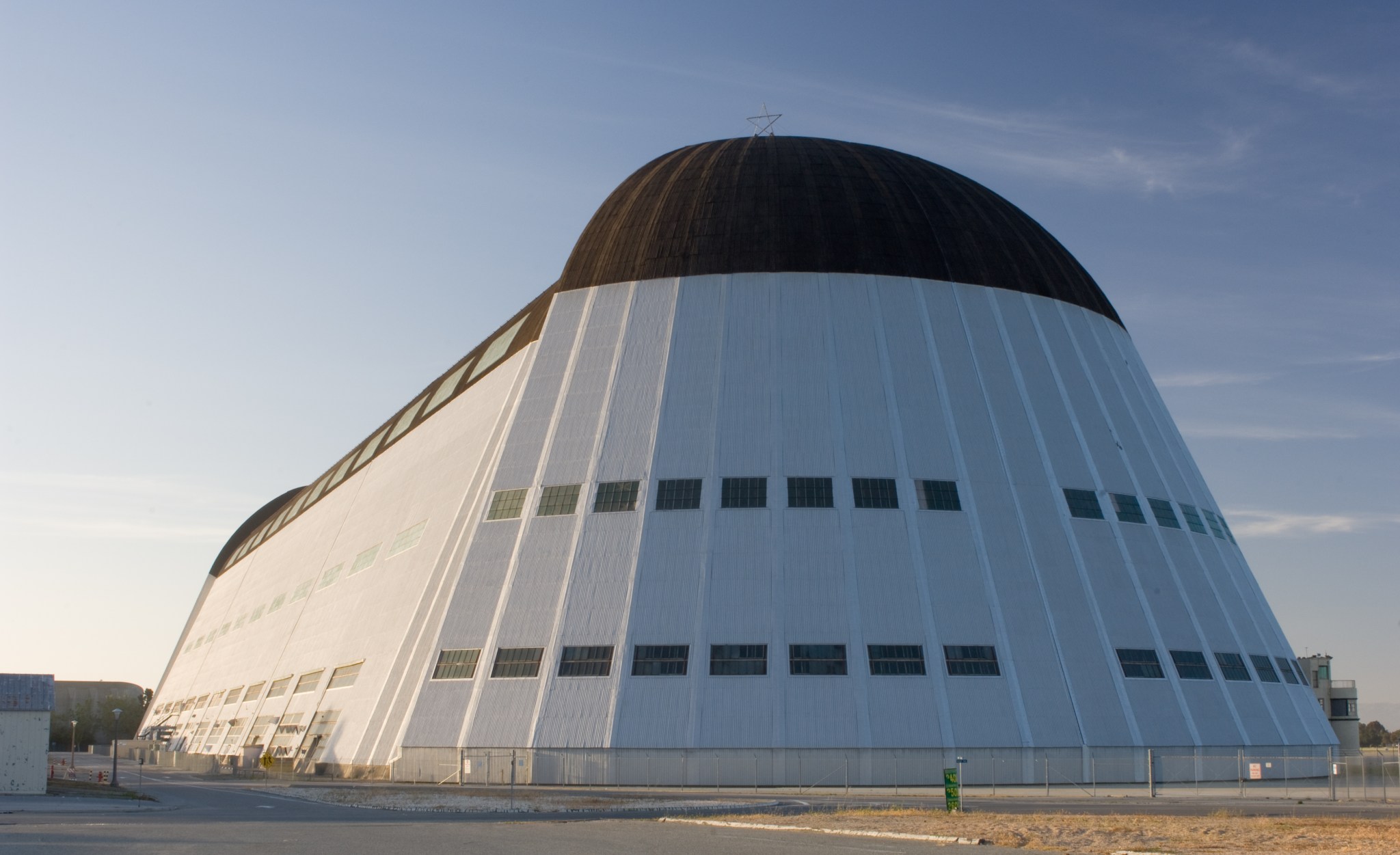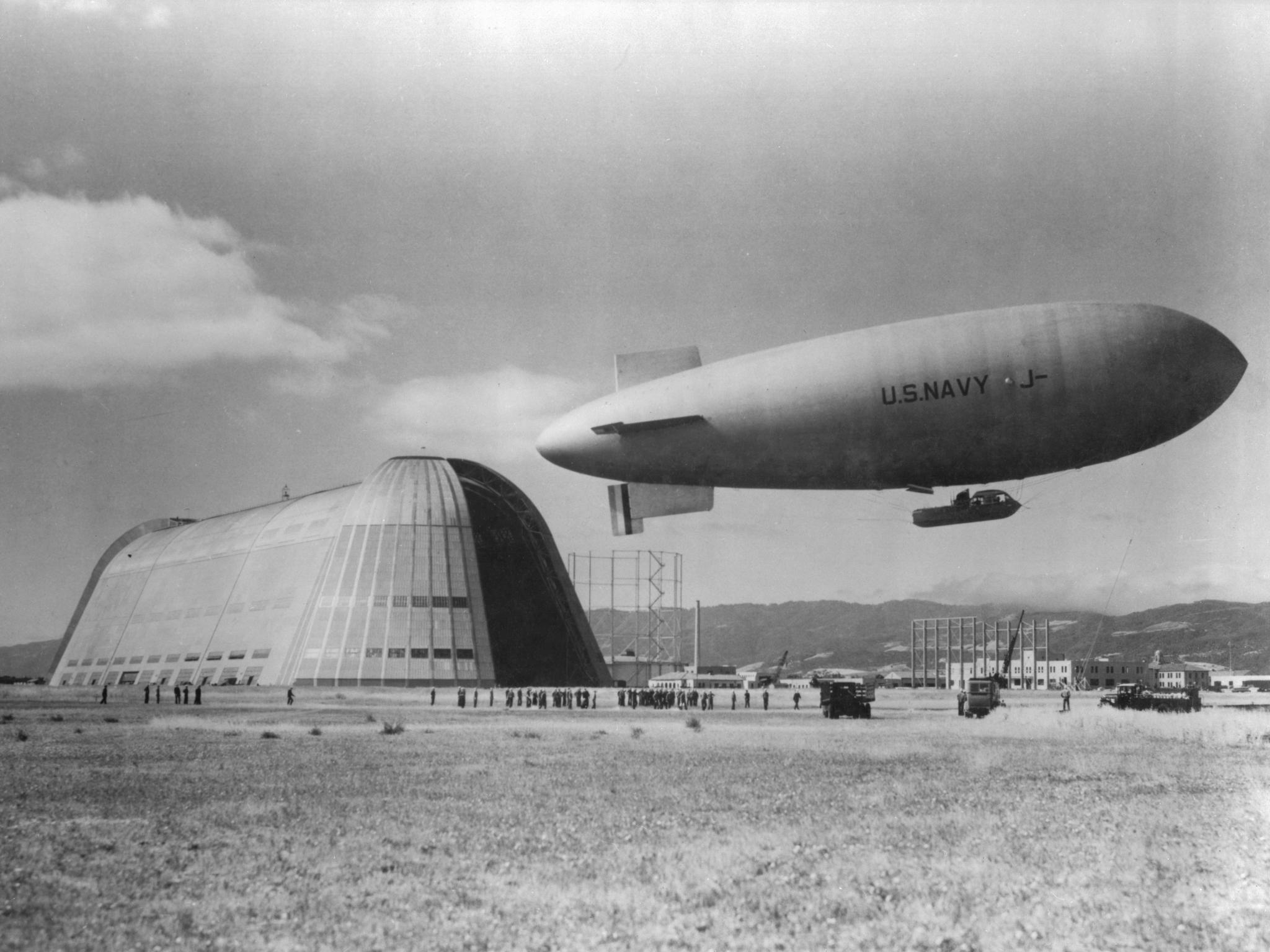A historic landmark in the San Francisco Bay Area and a part of the region’s early aviation history is being restored.
Engineers are about to undertake a massive restoration effort of this iconic landmark. After the remediation, clean-up, and restoration work is complete, Hangar One – now 90 years old – will be closer than ever to reuse.
Years ago, the Navy removed all the hangar’s roof, siding, windows, doors, and other materials, which were contaminated with toxic chemicals. The Navy then sealed the hangar’s structural frame with epoxy to ensure the chemicals would not pose a health risk, leaving it intact until further work could be completed.
Now the task of removing the remaining toxic chemicals from the hangar begins. First, working section by section, areas of Hangar One will be surrounded with scaffolding and encased to keep materials inside. Only then will the contaminated materials be carefully removed and stored in the vicinity of the hangar until they can be taken off-site for proper disposal. After the contaminated materials are removed, the steel frame will be primed and repainted to protect it from the elements until adding siding, windows, and doors can begin.
As each section is complete, several structural upgrades will also be made – to ensure the enormous hangar is seismically stable, for example – as well as other mechanical, plumbing, electric, landscape, and hardscape improvements.
The cleaning, repainting, and upgrades to the entire hangar are scheduled to be completed by 2025. Once Hangar One is fully restored, engineers plan for it to resemble, as closely as possible, its original visual characteristics.
Milestones:
- March 2022: Scaffolding and encasement around Hangar One begins.
- Spring 2022: Removal and disposal of contaminated materials begins.
- Summer 2022: Repainting of steel frame in the first work area begins.
- 2022-2025: Work continues in remaining work areas.
- 2025: Last of the scaffolding and encasement around final work areas is removed.
Timeline:
- 1933: The United States Navy built Hangar One at Naval Air Station Sunnyvale for the USS Macon airship and to serve as the West Coast base for the U.S. lighter-than-air aviation program.
- 1935: After the destruction of the dirigible U.S.S. Macon, Hangar One and all of Naval Air Station Sunnyvale was transferred to the U.S. Army, renamed Moffett Field Army Air Corps Base, and was used to house training aircraft.
- 1942: Moffett Field Army Air Corps Base was transferred back to the U.S. Navy and re-commissioned as Naval Air Station Moffett Field.
- 1994: The Navy transferred the hangar to NASA after Moffett Field was decommissioned.
- 1997: During routine stormwater testing, NASA discovered a toxin called polychlorinated biphenyls, or PCBs, specifically Aroclor 1260 and 1268, and other contaminants in the Center’s storm drain settling basin.
- 2002: Sampling programs determine that the composite corrugated material used to make the original external siding of Hangar One was the source of the PCBs as well as asbestos and the paint used to cover both the siding and steel frame of Hangar One contained lead and PCBs.
- 2003: An inspection reveals PCBs, and other contaminants are leaking from the hangar’s metallic exterior. As a result of the high levels of PCBs present in the Hangar One building components, the hangar was closed to human use, as required by the Toxic Substances Control Act.
- 2008: At a Navy public hearing, members of the local community expressed overwhelming support for full restoration of Hangar One.
- June 2010 – June 2013: The Navy addressed contamination at Hangar One by preserving and decontaminating historic artifacts; removing the hangar’s roof, siding, windows, doors, and other exterior components; demolishing the interior structures of the hangar; coating the structure with epoxy; among other activities.
- May 28, 2013: NASA and the U.S. General Services Administration issued a Request for Proposals to obtain lease proposals for the rehabilitation and adaptive reuse of Hangar One, and for the operation, management, and maintenance of Moffett Federal Airfield.
- February 2014: After a fair and open competition, the U.S. General Services Administration and NASA selected Planetary Ventures, LLC as the preferred lessee and began lease negotiations to manage Moffett Federal Airfield and rehabilitate historic Hangar One.
- Jan. 14, 2020: Engineering Evaluation/Cost Analysis (EE/CA) is approved by the U.S. Environmental Protection Agency (EPA) and the California Regional Water Quality Control Board (Regional Water Board).
- Nov. 17, 2020: Action Memorandum is approved by the EPA.
- Nov. 18, 2020: Action Memorandum is approved by the Regional Water Board.
- Feb. 3, 2022: Non-Time-Critical Removal Action (NTCRA) Work Plan is submitted to the EPA and the Regional Water Board.
- March 24, 2022: EPA and the Regional Water Board approved the Final Non-Time-Critical Removal Action Work Plan
Fast Facts:
- Hangar One is a very large structure measuring approximately 1,133 feet long, 308 feet wide, and 198 feet high.
- Hangar One is in the Shenandoah Plaza Historic District, which is listed in the National Register of Historic Places at the National level of significance under
- Criterion A for the association with coastal defense and naval technology that has made a significant contribution to the broad patterns of our history; and
- Criterion C reflecting the distinctive type, period, method of construction and high artistic values that are represented in the 1933 station plan and buildings.
- Hangar One is designated as a Naval Historical Monument as well as a California Historic Civil Engineering Landmark by the San Francisco section of the American Society of Civil Engineers.
Collaborators:
- Planetary Ventures, LLC of Delaware
Learn more:
- NASA story: Second Life for Historic Hangar One Wood: Super Bowl 50 Stadium Décor (Feb. 1, 2016)
- NASA video: Second Life for Hangar One Wood (Feb. 3, 2016)
- NASA release: NASA Signs Lease with Planetary Ventures LLC for Use of Moffett Airfield and Restoration of Hangar One (Nov. 10, 2014)
For researchers:
- NASA Ames’ Environmental Divisions’ Federal Facility Agreement Administrative Record webpage
- NASA Historic Preservation Office Hangar One webpage
- 2008 Archive: Hangar One webpage
For news media
- Members of the news media interested in covering this topic should reach out to the Ames newsroom.




























